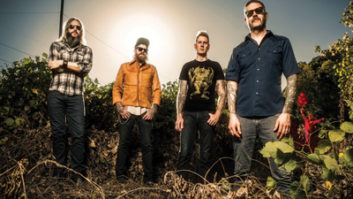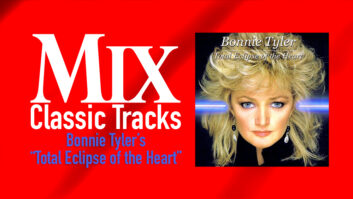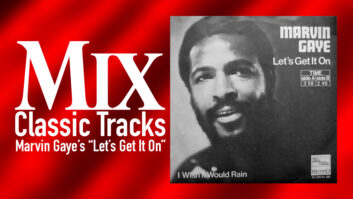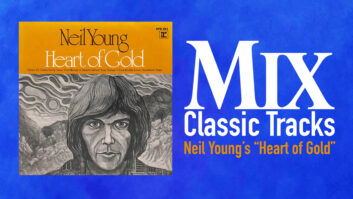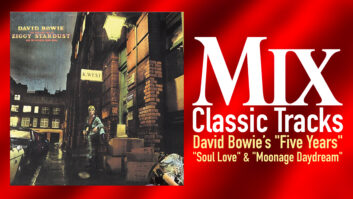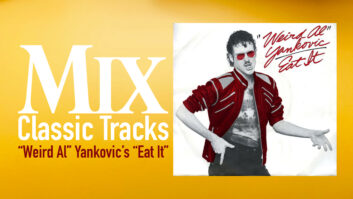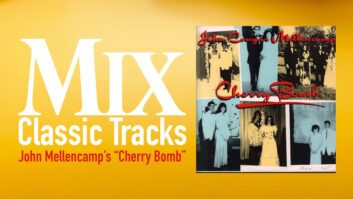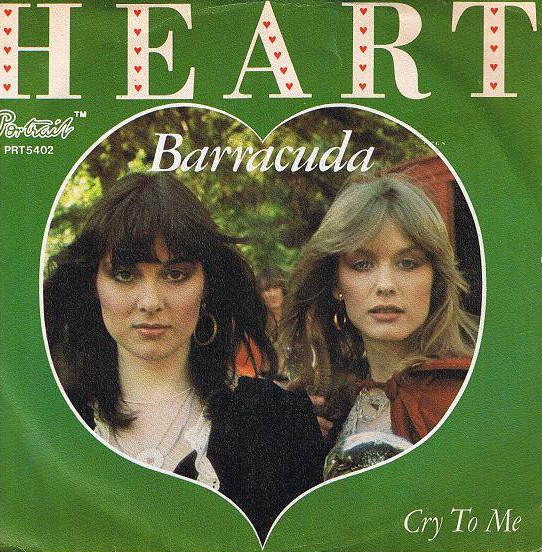 The first time I saw Heart perform, in 1975, they were second or third on the bill at a show headlined by the recently formed Jefferson Starship at the 5,000-seat Winterland Arena (one-time home of the Ice Follies) in San Francisco. Heart was virtually unknown at the time-their debut album, Dreamboat Annie, had just been released, and although they were getting some FM airplay with a catchy rocker called “Crazy On You,” there wasn’t even really a buzz about them yet. After their set at Winterland that night, however, 5,000 people sure as hell knew who they were. Here was a band fronted by two women (very unusual at the time) that rocked as hard as Led Zeppelin-they even closed their set with the Mighty Zep’s “Rock and Roll”-but also infused many of their tunes with a lovely folkish delicacy. Singer Ann Wilson showed an enormous range as she led the group through a collection of catchy originals and cover tunes. They earned a heartfelt encore from the crowd that night, and I wasn’t at all surprised when their rise to stardom accelerated in the following months.
The first time I saw Heart perform, in 1975, they were second or third on the bill at a show headlined by the recently formed Jefferson Starship at the 5,000-seat Winterland Arena (one-time home of the Ice Follies) in San Francisco. Heart was virtually unknown at the time-their debut album, Dreamboat Annie, had just been released, and although they were getting some FM airplay with a catchy rocker called “Crazy On You,” there wasn’t even really a buzz about them yet. After their set at Winterland that night, however, 5,000 people sure as hell knew who they were. Here was a band fronted by two women (very unusual at the time) that rocked as hard as Led Zeppelin-they even closed their set with the Mighty Zep’s “Rock and Roll”-but also infused many of their tunes with a lovely folkish delicacy. Singer Ann Wilson showed an enormous range as she led the group through a collection of catchy originals and cover tunes. They earned a heartfelt encore from the crowd that night, and I wasn’t at all surprised when their rise to stardom accelerated in the following months.
The daughters of a Marine captain, Ann and Nancy Wilson grew up in Southern California and Taiwan before settling in the suburbs of Seattle. There they each pursued music independently in their late teens and early 20s. Nancy was a folk singer, and Ann was fronting a group called The Army, led by guitarist Roger Fisher and bassist Steve Fossen, which later changed its name to White Heart and finally, in 1974, to Heart. It was in that year, too, that Nancy Wilson joined the band. The following year, in part to allow Roger Fisher’s brother Mike, who had been in the band earlier and then worked as their soundman, to avoid the draft, the band relocated to Vancouver, British Columbia.
Around the time Ann and The Army were hooking up, a young producer/engineer named Mike Flicker was moving to Vancouver after several years of studio work in Los Angeles. “They had a lot of talented people up there,” he recalls of the very early ’70s, “but they really didn’t have any recording facilities worth anything. At that point I think there were two 8-track studios and one didn’t even have a console; they were mixing off the playback controls of the multitrack machines there.”
After being in Vancouver for a while, Flicker got wind that someone was actually attempting to build a good studio in town. “The guy who was building it basically had a broadcast studio in his mind with the thought that someday it could also be a recording studio, but he was building it properly. It was built halfway into a hillside, and he was going to put some good equipment in there. Unfortunately, in midstream he had some health problems and was forced to retire. So with help from some investors we bought his half and then put together the first 16-track studio in Vancouver. Back then it was called Can Base Studios [short for Canadian Base], which was the name of the investment company. Later it became known as Mushroom Studios.”
Flicker equipped the studio with an Ampex MM1000, 2-inch 16-track-“which is what we recorded Dreamboat Annie on,” he says-and a custom console “we bought in a fire sale from United Artists, when they owned UA and Western Studios. They were putting in new solid-state consoles and we bought one of their old tube boards from United Studio A. That console is the guts of part of the front end of the board that still sits in there after three or four different reincarnations. It was a good console but only had 18 tube preamps.” The cinderblock studio room had a 20-foot ceiling, and Flicker notes that “we were working on LEDE [Live End, Dead-End ] principles that were popular at the time. The studio quickly became the hottest recording room in town, and Flicker began to establish himself as a draw to the studio as well.
Flicker first met the Wilson sisters in 1974. “My second engineer, a guy named Rolf Henneman, came into the studio one day and said, ‘I just saw this band in a club that just blew me away!’ I said, ‘Sure, sure, sure,’ and went back to doing whatever I was doing. After about ten times of him saying this to me over the next couple of months, he brought me a cassette he’d made on a hand-held cassette recorder, and he played it for me, and he was right. At that point in time they were probably only playing one or two original songs; they mostly played covers. This was also prior to Nancy joining the band. Then Nancy joined, and around then was the first time I ever saw them play live.” Flicker was so impressed that he approached the group about working with them.
“In those days in Canada you didn’t even necessarily record an album,” Flicker says. “You mostly recorded singles, and then if there was some airplay you’d go and try and get a deal in the United States, and then you’d go in and do a whole album. And that’s what we tried to do with Heart, but nobody was interested. The critique I got all the time was, ‘Well, are they this rock band or are they that ballad band? Are they hard rock? Who are they?’ They were neither fish nor fowl, but that was their whole sound-they were both.”
The band’s first album, Dreamboat Annie, was recorded at Mushroom Studios in 1975. “That record was really less a band album than a collaboration of the two singer/songwriters-Ann and Nancy-and myself as producer and song and music editor. They would present the songs to me because they didn’t have a working band worthy of recording really; after I signed them to the label they were changing members every week for a while there. So we would take the songs and rehearse them with whoever the band was and with other studio musicians. At that point, one of my collaborators in production was Howard Leese, who later joined the band as a guitarist and keyboardist.”
Sessions for the album were straightforward and went fairly quickly. Flicker says that conceptually and sonically, the album was influenced by the work of two British recording masters, producer George Martin and engineer Gus Dudgeon. “Dreamboat Annie was put together as a conceptual piece, a bit like The Beatles had done with Sgt. Pepper, and that was pretty unusual for 1975.” Then came the long, slow process of building the band’s popularity.
“What ended up happening is that through some investors in Canada, we ended up starting a U.S. record company, Mushroom Records,” Flicker recalls. “But we didn’t have the money to nationally market, so wherever the group would gig, we’d get a local distributor to make sure they had some records in the stores. Once we started to get some airplay on ‘Crazy On You’ and ‘Magic Man,’ things started to snowball, and then the distributors all wanted the record. But it took about nine months to get national distribution.”
It helped, too, that Heart had a kick-ass live show and an incredible work ethic-the band toured almost nonstop during all of 1976. The FM radio success of the two songs Flicker mentioned led to those songs being released as singles, and with that came even greater success. “The only time we had a chance to work on new material is when I flew out on the road and they had a day off,” Flicker says. Eventually, though, they found time to cut basic tracks at Mushroom on four songs for their sophomore album, which was going to be called Magazine. That’s when the problems began.
While the group was making the record, Flicker went back to the investment group that controlled Mushroom Records, to try to renegotiate the group’s contract, “because frankly their first record deal was a ‘baby band’ record deal based on a Canadian-based record contract. And by this time they were much bigger than that and had had a lot of success in the U.S., of course.” Flicker wanted to renegotiate terms that were more favorable to the group, and in return sign a deal that would give Mushroom the rights to the next three Heart albums, but to his surprise and chagrin, the investment group turned Flicker down.
“I had a rude surprise,” Flicker says. “Basically, what they said was, ‘Rather than gamble that the group will continue to be popular, we’re going to be short-sighted and keep to the deal we have and we don’t care if we get anything extra.’ So the next day I resigned. I said, ‘I can’t even present this to the group.’ A little part of the contract that some people had apparently overlooked was that the group had signed to the label based on the fact that I was at the record company. So a couple of days went by, [the investment group] presented their offer to the group but the group said, ‘Since Mike’s not there, we’re leaving; goodbye.’
“The short version of a very long and dirty story is that we ended up in the position of losing the four songs that had been the start of the second album, and we found ourselves having to start over again, and that became the birth of the second album, Little Queen, which was on Portrait/CBS. And ‘Barracuda’ was created conceptually out of a lot of this record business bullshit. Barracuda could be anyone from the local promotion man to the president of a record company. That is the barracuda. It was born out of that whole experience.”
While Heart was dragged into endless rounds of legal wrangling over the fate of their contract and their recording masters, the band moved south to Seattle’s Kaye Smith Studios to try recording anew. Built in 1972, the facility was co-owned by actor/comedian Danny Kaye and businessman Lester Smith; they also owned several radio stations together and later were the original owners of the Seattle Mariners baseball team.
Flicker says the two-room studio was equipped with a pair of great-sounding API consoles, with the 550 equalizers on each channel. “We got them to change out all the old soft switching and put in Jensen transformers, which was a magic combination with the APIs. Also, they had 3M recorders, but I refused to use them,” he says. “Part of the deal of getting us to work there was that they would bring in Ampex recorders.” They mostly used MM1200 16-tracks running with an Adams-Smith synchronizer. “The next albums were done on 16 and 24 running dual machines,” Flicker notes. “We’d do the basic tracks on 16, overdubs on 24. If you’re running it 30 ips and you want some low end, you’ve got to have some width to the head. That’s why the 16 was so great.”
Because Heart had been on the road for a year and honed their sound and truly become a band for the first time, recording Little Queen was relatively easy. Basics were cut live with the entire band, with Ann Wilson in a separate booth for her scratch vocals, “because some of those scratches became the real thing,” Flicker says. “It was a performance by the whole band always,” though he adds that guitar solos were always done as overdubs.
“Our work ethic was always to try to capture a feel,” Flicker says. “We would never work songs to death. We’d go in the studio, and if it wasn’t happening for some reason, we’d go home and try it again the next day. I remember on ‘Barracuda,’ the group was rehearsing it in a room off their manager’s office, and then we went in right after that and cut it. It was one of those songs that was written one day, rehearsed in one day and recorded in one day. It was a very spontaneous, but also a well-thought-out song. In my opinion that song was the turning point where it was clear that Heart was now a group, and not just these songwriters and a few musicians.” The song’s famous opening riff was conceived by guitarist Roger Fisher. “It was a truncation of another riff that he loved, and then he turned it into a song,” Flicker notes.
The song was cut in Kaye Smith Studio B: “At that point [Studio B] was a Hidley room and it was very dead on one side and very live on the other. When we started working there, I began to use a few more digital effects, which were just starting to come out then, to make the room sound a little bigger. I used Eventide Clockworks, as well as some regular EMT plates they had. I also used this really ugly digital delay system to create live room distortion. It was an MXR DDL and I still have them and occasionally use them. It was so cheap and so ugly that once you got beyond about 160 milliseconds there was nothing above 5k. You could actually go out as far as a second, but by the time you got there, there was no frequency response above 2,500. If you stand in a live arena and you get a bounce that’s a second later, what’s the frequency response? It’s shit. But that’s a little of the sound I was going for-not ‘shit,’ but…The repeating sound on the vocals of ‘Barracuda’ is the MXR DDL, and you can’t get any lower-fi than that.”
Flicker used a Neumann 87 on Ann Wilson’s lead vocal. “In fact that was the only mic I ever used on her. And it was a particular 87. When I first started recording her, I tried out every microphone I could find on her. I wouldn’t let anyone tell me which mic I was listening to, and I found this one 87 that was perfect. The Neumann guy had brought in like 12 87s I found this one that I loved.”
To capture the band’s hard rock guitar crunch, Flicker always used two mics: a Beyer M69 on the amp (“because of its great, warm low-midrange”) and then, farther away in the room, “a Neumann 67 or 87, depending on the room, or maybe an AKG C-12 or C-21.”
Flicker liked to have drummer Michael Derosier in the same room with the other players, but heavily baffled. “I used mostly Neumann condensers for close-miking, except for the snare-I’ve always been an SM57 fan for the top snare; for the bottom I’d use an 84 or some of the AKG pencil mics of the time. It’s been so long since I’ve miked drums I can’t remember the numbers; they were forerunners of the 451s and 452s.” For the kick he used a D112; for floor toms, RE20s.
While the group was working on Little Queen, some major improvements were being made in Kaye Smith Studio A, which Flicker says was “so dead it was like recording in a marshmallow; everyone preferred B,” and during the final phase of the project Flicker mixed on the API in A while continuing to record overdubs in B.
Meanwhile the legal battle continued to snake its way through the courts. I’ll spare you the gory details about what various circuit court judges said about the issues at hand, but the Cliff Notes version is that the band eventually won the right to complete ownership of the basic tracks they’d been working on for the Magazine album. (This was after Mushroom tried to put out an album based on those songs and some live performance tapes they controlled; about 50,000 copies were distributed before a judge blocked it.) Little Queen was completed at Kaye Smith and became a huge hit, reaching Number 9 on the album charts, while “Barracuda” swam up to Number 11 on the singles chart. The title track and “Kick It Out” also charted from that album. Flicker continued working with the group for four more albums (Magazine, Dog and Butterfly, Bebe Le Strange and Live), and Heart’s string of successes went well into the ’80s.
Kaye Smith eventually became Bad Animals Studios, and Heart had their own room there for many years. Today, the Wilson sisters still tour together periodically, and many of their songs are staples on “classic rock” radio. Mike Flicker is currently head of Mike Flicker Music Services, an L.A.-based company that specializes in music editorial and music supervision for films and television.
